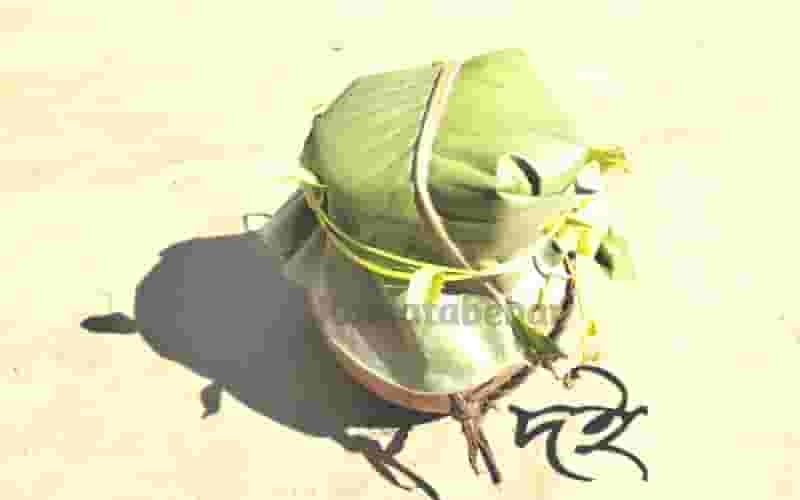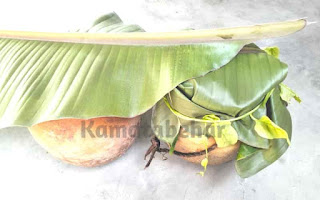কামতাপুরী সমাজে দই
কামতাপুরী সমাজে দই কে দধি বা দহি বলে। গ্রামাঞ্চলে এখনো দধি শব্দটির চল আছে। কামতাপুরী সমাজে নানারকম এর দই এর প্রচলন ছিল যার বেশীরভাগই আজকাল আর দেখা যায়না। So many dahi variants found in Kamatapuri society or Kamatabehari society that are not seen now a days.
Dahi variants in Kamatapuri Society.
ডঃ চারুচন্দ্র সান্যালের Rajbanshi's of Northbengal বইতে কোচ রাজবংশী সমাজের বিভিন্ন রকমের দই এর বিবরণ আছে। গ্রামে থাকার সুবাদে আমিও বিভিন্ন প্রকার দই এর নাম সম্পর্কে অবগত হয়েছিলাম। কামতাপুরী সমাজে নানারকম দই
গলেয়া দই / Goleya Doi
কিছু পরিমান মোষের দুধ নিয়ে 1/4 ভাগ মাঠা বা সর তুলে ফেলে দুধের সঙ্গে ওই সমান পরিমাণ জল মিশিয়ে ফোটানো হয়। ঠান্ডা হয়ে এলে মাটির ভাঁড়ে দুধ ঢেলে তার সঙ্গে পুরনো কিছুটা দইয়ের সাজা (Dahi culture) ভাঁড় ভরতি দুধের মধ্যে মেশানো হয়। দই তৈরির জন্য দুধকে প্রায় বারো ঘণ্টা গেজতে দেওয়া হয় এবং এভাবেই দই তৈরি হয়ে যায়। এর স্বাদ খুব টক নয়। ম্যালেরিয়া, পক্স এবং হামের রুগিদের দই খাদ্য হিসাবে দেওয়া হয়।
ট্যাঙ্গা দই, ঝ্যাল ট্যাঙ্গা দই / Tenga doi, jhal tenga doi
একই রকম পদ্ধতিতে দই পেতে যদি তিন থেকে পাঁচদিন অবদি রাখা হয় তখন দই বেশ আঠালো হয়ে ওঠে। কখনও ছোট ছোট পোকাকে দইয়ের ওপর ঘুরে বেড়াতে দেখা যায়। তখন বোঝা যায় দই বেশ জমে উঠেছে। এর স্বাদ খুব টক। গ্রীষ্মে এই খাবার খুবই প্রিয়। এই দই সংরক্ষণের জন্য আস্তে আস্তে দইয়ের ওপর জল ঢালা হয় যা দইয়ের ওপর একটা সুরক্ষা বলয় তৈরি করে।
নালুয়া দই / Nalua doi
দই যখন খুব আঠালো আকার নেয় তাকে নালুয়া দই বলে।
গারস্তি দই / Garasti doi
সাধারণত ‘কারিয়া’ নামক বাঁশের চোঙে গারস্তি দই পাতা হয়। খাঁটি দুধ, অধিকাংশ সময়ই মহিষের দুধ না ফুটিয়ে ‘কারিয়া’তে অথবা ছোট আকারের নতুন মাটির পাত্রে রাখা হয়। এখানে দই পাতার জন্য কোনও সাজা (culture) ব্যবহার করা হয় না। গরমকালে এই দুধ ১২-২৪ ঘণ্টা আর শীতকালে প্রায় ৭২ ঘণ্টা এইভাবে রেখে দেওয়া হয়। এইভাবে শক্ত দই তৈরি হয় এবং নীচের পরিষ্কার তরলের ওপর এটি ভেসে থাকে। এর মধ্যে কোনও রকম মিষ্টি মেশানো হয় না। এর স্বাদ খুব ভাল (টক নয়) আর এটা পুরো সর পড়া দই। পূজার জন্য ব্যবহার করা হয় এই দই।
ছাঁচি দই বা ছাচি কাচা দই / Chachi doi or Chachi kacha doi
গোরু বা মোষ উভয়ের দুধ থেকে এই দই তৈরি হয়। এটাও পুরো সর। দুধ গরম করে এবং প্রায় ঠান্ডা হয়ে এলে এর সঙ্গে দইয়ের সাজা আস্তে আস্তে মিশিয়ে ১২ ঘণ্টা দই পেতে রাখতে হয়। এইভাবে শক্ত দই জমে ওঠে আর এটা খেতেও টক হয় না। নতুন মাটির পাত্রে এই দই বসানো হয়। পাত্রে দুধ ঢালার আগে উনুনে গরম করে নিতে হয়।
কাচা দই / Kacha doi
মোষের দুধ থেকে এই দই সাধারণত শীতকালে পাতা হয়। গরম করা নতুন মাটির পাত্রে অথবা বাঁশের চোঙে (কারিয়া) কাঁচা দুধ রাখা হয়। কোনও সাজা মেশানো হয় না। কোনও কোনও অঞ্চলে দুধে সামান্য তেঁতুল মেশানো হয়। প্রতিদিন এতে কিছুটা টাটকা কাঁচা দুধ দেওয়া হয়। ছয়-সাতদিন ধরে দই তৈরি হয় আর এটা যখন বেশ স্পঞ্জি বা ফাঁপানো ছিদ্রযুক্ত হয় তখন বলা হয় দই বসেছে।
আমা কাচা দহি / Aam kacha doi
গোরু বা মহিষের সরযুক্ত দুধ বা কখনও দুটো দুধ মিলিয়ে এটি তৈরি করা হয়। দই পাতার জন্য পুরনো দইয়ের সাজা ব্যবহার করে প্রায় ১২ ঘণ্টা রাখা হয়। দই শক্ত হয়ে জমে, এতে প্রচুর ফ্যাট থাকে। সাধারণত শীতের সময় এটা জমানো হয়। এটি খুব উৎকৃষ্ট ধরনের দই।
ডাঙ্গা দই, দাকরা দই / Danga doi , Dakra doi
গোরু বা মহিষের দুধ থেকে এটিও তৈরি করা হয়। দুধের পুরো সর তুলে ফেলে এতে প্রায় অর্ধেক পরিমাণ জল মিশিয়ে ফোটানো হয়। ঠান্ডা হয়ে এলে, দই বসানোর জন্য এর সঙ্গে গেঁজে ওঠার কোনও উপকরণ, সাধারণত পুরনো দই মিশিয়ে সরিয়ে রাখা হয়। ১২ ঘণ্টা পর যে দই তৈরি হয় তার স্বাদ খুব সুন্দর। ২৪ ঘণ্টা পর সেটা খুব টক হয়ে যায়। টক দইটা সবাই খুব পছন্দ করে। অতিথিদের এই দই খাওয়ানো হয় আবার কুটুমের বাড়িতে প্রথম বার যাবার সময় নিয়ে যাওয়া হয় এই দই।
নানুয়া দই / Nanua doi
গোরু বা মোষের দুধ থেকে তৈরি, পুরো দুধে প্রায় অর্ধেকের ওপর জল মিশিয়ে ফোটানো হয়। প্রায় ঠান্ডা হয়ে এলে পরিষ্কার করে ধোওয়া কয়েকটা কেঁচো (চ্যারাও) দুধের সঙ্গে মেশানো হয় যা দুধ গেঁজানোর কাজ করে। ৩-৫ দিনের মধ্যে দই তৈরি হয়। কেঁচোগুলি যে পাত্রে দই পাতা হয় তার ওপরের দিকে থাকে সুতরাং দই থাকে পোকা মুক্ত। এই দই খেতে খুব টক। কোথাও আবার জ্যান্ত কেঁচোর বদলে তাদের রস মেশানো হয়। সব রকম দই-ই গুড় বা লবণ দিয়ে খাওয়া হয়। বর্তমানে অবশ্য এইরকম চ্যারাও বা কেঁচো দুধের উপর দিয়ে দই পাতানো দেখা যায় না।
# English version #
Dr. Charuchandra Sanyal's book 'Rajbanshi's of North Bengal describes various types of curds or dahi of Koch Rajbanshi society. Living in the village I also came to know about the names of different types of curd.
Types of curds were prevalent in Kamatapuri society.
Goleya Dahi
Take some amount of buffalo milk, pull out 1/4 part of cream and mix the same amount of water with milk and boil it. When it gets cold, milk is poured into an earthen pot and some old curd is mixed with it in the pot filled milk. To make curd, the milk is allowed to ferment for about twelve hours and thus the curd is formed. Its taste is not very sour. Curd is given as food to malaria, pox and measles patients.
Tenga Dahi, Jhyal Tenga Dahi
If curd is kept for three to five days in a similar manner, the curd becomes quite sticky. Sometimes small insects are seen crawling on the curd. It is understandable then that the curd is formed desired level. Its taste is very sour. This dish is very popular in summer. To preserve this curd, water is slowly poured over the curd which creates a protective ring over the curd.
Nalua Dahi
When curd becomes very sticky it is called Nalua curd or Nalua dahi.
Garasti Dahi
Generally, Garasti curd is made in bamboo cylinder called 'Karia'. Pure milk, mostly unboiled buffalo milk, is kept in 'Karia' or small new earthen vessels. Here no saja or dahi culture is used for curd making. The milk is kept like this for 12-24 hours in summer and about 72 hours in winter. In this way solid curd is formed and floats on the clear liquid below. No sweeteners are added. It tastes very good (not sour) and it is whole curd. This curd is used for worship or Puja purpose.
Chhachi Dahi, Chhachi Kacha Dahi
This curd is made from the milk of either cow or buffalo. It is full of cream or 'Sor'. Heat the milk and when it is almost cold, slowly mix the curd with it and keep it for 12 hours to get the curd. In this way the curd becomes hard and it is not sour to eat. This curd is placed in a new earthen vessel. Before pouring the milk in the pot, it should be heated.
Kacha Dahi
This curd is usually made from buffalo milk in winter. Raw milk is kept in heated new earthen pots or bamboo cylinder (karia). No culture or saja is involved. In some regions a little tamarind is mixed with milk. Every day some fresh raw milk is given in it. The curd is formed for six to seven days and when it is quite spongy or has hollow pores, the curd or dahi is said to have set.
Aam Kacha Dahi
It is made from cow's or buffalo's whole fat milk or sometimes a combination of the two. For making this type aam kacha dahi, old curds are used and kept for about 12 hours. Dahi becomes hard accumulated mass, it contains a lot of fat. Usually it is made during winter. It is a very good type of curd.
Danga Dahi, Dakra Dahi
It is also made from cow or buffalo milk. After taking out the fat or cream of milk, it is mixed with about half the amount of water and boiled. After cooling, the milk is mixed with old curd to set the curd. After 12 hours the curd which is made tastes very good. After 24 hours it becomes very sour. Sour curd is loved by everyone. The guests are welcomed with this curd and this curd is taken to relatives' house for the first time.
Nanua Dahi
It is made from cow or buffalo milk, whole milk is boiled with about half of water. When it is almost cold, a few earthworms (cherao) washed clean are mixed with the milk which ferments the milk. Dahi is formed in 3-5 days. The earthworms live on the top of the container where the curd is set, so the curd remains insect free. This curd is too sour to eat. Somewhere, instead of earthworms, their body fluid is mixed. All types of curds are eaten with jaggery or salt. At present, however, such curds are not seen to be prepared by milk mixed with earthworm.



